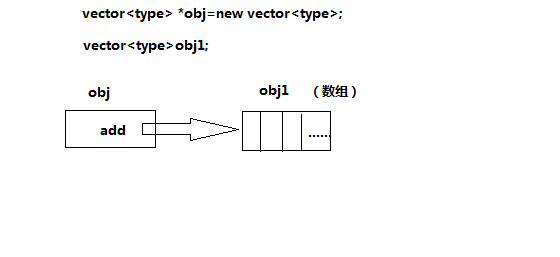由上一节中了解vector基本使用,但是往往编程中使用vector复杂类型创建对象,因为泛型编程中类型的自由。
这样使得对象变得更为复杂。
1、二维数组
定义:
vector<vector<type>> obj;
#include<iostream>
#include<vector>
#include<string>
#include<ctime>
using namespace std;
//二维数组遍历
//迭代器
void reverse_with_iterator(vector<vector<int>> vec)
{
if (vec.empty())
{
cout << "The vector is empty!" << endl;
return;
}
vector<int>::iterator it;
vector<vector<int>>::iterator iter;
vector<int> vec_tmp;
cout << "Use iterator : " << endl;
for (iter = vec.begin(); iter != vec.end(); iter++)
{
vec_tmp = *iter;
for (it = vec_tmp.begin(); it != vec_tmp.end(); it++)
cout << *it << " ";
cout << endl;
}
cout << endl;
}
//得到行、列大小,利用下标进行遍历
void reverse_with_index(vector<vector<int>> vec)
{
if (vec.empty())
{
cout << "The vector is empty!" << endl;
return;
}
int i, j;
cout << "Use index : " << endl;
for (i = 0; i < vec.size(); i++)
{
for (j = 0; j < vec[0].size(); j++)
cout << vec[i][j] << " ";
cout << endl;
}
cout << endl;
}
int main()
{
//二维数组的实现
vector<vector<int>>vec1(3);//数组的行
for (int i = 0; i < 3; i++)
vec1[i].resize(3);//数组的列
for (int i = 0; i < vec1.size(); i++)
{
for (int j = 0; j < vec1[0].size(); j++)
vec1[i][j] = i*j;
}
for (int i = 0; i < vec1.size(); i++)
{
for (int j = 0; j < vec1[0].size(); j++)
cout<<vec1[i][j] <<" ";
cout << endl;
}
cout << endl;
vec1.resize(5);//调整vec1行数
vec1[3].resize(3);//补充剩余行的列数
vec1[4].resize(3);
for (int i = 0; i < vec1.size(); i++)
{
for (int j = 0; j < vec1[0].size(); j++)
vec1[i][j] = i*j;
}
reverse_with_iterator(vec1);
cout << endl;
//或
vector<vector<int>> vec2;
vector<int> a2;
a2.push_back(1);
a2.push_back(2);
a2.push_back(3);
vector<int> b2;
b2.push_back(4);
b2.push_back(5);
b2.push_back(6);
vec2.push_back(a2);
vec2.push_back(b2);
reverse_with_index(vec2);
cout << endl;
system("pause");
return 0;
}
2、元素指针
定义:
vector<type *> obj;
相当于指针数组(即数组中的每个元素都是指针)。
元素访问形式:*obj[i];
对象obj中的每个元素的类型均是type *
#include<iostream>
#include<vector>
#include<string>
using namespace std;
//指针元素遍历
template<typename T>
void Output(T vec)
{
for (int i = 0; i < vec.size(); i++)
{
cout << *vec[i] << " ";
}
cout << endl;
}
//或
template<typename T>
void Output0(T vec)
{
T::iterator iter = vec.begin();
for (; iter != vec.end();)
{
cout << **iter++ << " ";
}
cout << endl;
}
int main()
{
//元素指针
vector<int*> vec;//vec中的每个元素的类型是int*(存储整型的地址)
int a = 8, b = 9;
vec.push_back(&a);//vec[0]=&a;
vec.push_back(&b);//vec[1]=&b;
Output(vec);
Output0(vec);
cout<<"val:"<<*vec[0]<<endl;
vector<string*>vst;
string st1 = "Hello";
string st2 = "world";
vst.push_back(&st1);
vst.push_back(&st2);
Output(vst);
Output0(vst);
system("pause");
return 0;
}3、对象指针
定义:
vector<type> *obj=new vector<type>; 必须要分配空间
取出对象中的元素:
obj[i]、*(obj[i])=*obj[i]、(*obj)[i]选择哪个?
vector<type>可以简单理解为type [ ]
则vector<type> *obj---------->type [ ] *obj,相当于数组指针。
元素访问选取(*obj)[i]
#include<iostream>
#include<vector>
#include<string>
#include<ctime>
using namespace std;
int main()
{
//对象指针
//使用方法先定义、初始化,在创建该指针前的类型的对象
//遇到复杂类型的对象,需要拆开
vector<int> *vec3 = new vector<int>;//创建对象指针
vector<int> vec4;// 创建普通对象
vec4.push_back(1);
vec4.push_back(2);
vec3 = &vec4; //将普通对象的地址赋给指针
cout <<(*vec3)[1]<< endl;//去除对象中的元素
system("pause");
return 0;
}
4、创建对象指针的元素类型也为指针
定义:
vector<type*> *obj; 可以暂不分配空间。
元素访问:参考2、3点
#include<iostream>
#include<vector>
using namespace std;
int main()
{
int a = 8, b = 9;
//创建对象指针中元素也为指针
vector<int*>*vec5;
vector<int*>vec6;
vec6.push_back(&a) ;
vec6.push_back(&b);
vec5 = &vec6;
cout << *(*vec5)[1] << endl;
system("pause");
return 0;
}
5、自定义类
#include<iostream>
#include<vector>
using namespace std;
class Myclass
{
public:
Myclass(){};
Myclass(int n)
{
this->n = n;
}
int n;
void fun()
{
cout << "fun" << endl;
}
};
int main()
{
vector<Myclass>vec;
Myclass p(6);
Myclass q;
vec.push_back(p);
cout << vec[0].n << endl;
vec[0].fun();
vector<Myclass*>vec1;
Myclass *p1=new Myclass(1);
Myclass *p2 = new Myclass(2);
Myclass *p3 = new Myclass(3);
vec1.push_back(p1);
vec1.push_back(p2);
vec1.push_back(p3);
//方法1
for (int i = 0; i < vec1.size(); i++)
{
cout << vec1[i]->n << " ";
vec1[i]->fun();
}
cout << endl;
//方法2
for (int i = 0; i < vec1.size(); i++)
{
cout << vec1.at(i)->n << " ";
vec1.at(i)->fun();
}
cout << endl;
//方法3
for (vector<Myclass*>::iterator iter = vec1.begin(); iter != vec1.end(); iter++)
{
cout << (**iter).n << " ";
(**iter).fun();
}
cout << endl;
delete p1;
delete p2;
delete p3;
system("pause");
return 0;
}6、综合示例
#include<iostream>
#include<vector>
#include<string>
using namespace std;
class Student
{
public:
string m_strNO;
string m_strName;
string m_strSex;
string m_strDate;
public:
Student(string strNO, string strName, string strSex, string strDate)
{
m_strNO = strNO;
m_strName = strName;
m_strSex = strSex;
m_strDate = strDate;
}
void Display()
{
cout << m_strNO << "\t";
cout << m_strName << "\t";
cout << m_strSex << "\t";
cout << m_strDate << "\t";
}
};
class StudCollect
{
vector<Student> m_vStud;
public:
void Add(Student &s)
{
m_vStud.push_back(s);
}
Student* Find(string strNO)
{
bool bFind = false;
int i;
for (i = 0; i < m_vStud.size(); i++)
{
Student& s = m_vStud.at(i);
if (s.m_strNO == strNO)
{
bFind = true;
break;
}
}
Student *s = NULL;
if (bFind)
s = &m_vStud.at(i);
return s;
}
};
int main()
{
Student s1("1001", "zhangsan", "boy", "1988-10-10");
Student s2("1002", "lisi", "boy", "1988-8-25");
Student s3("1003", "wangwu", "boy", "1989-2-14");
StudCollect s;
s.Add(s1);
s.Add(s2);
s.Add(s3);
Student *ps = s.Find("1002");
if (ps)
ps->Display();
system("pause");
return 0;
}
待续。。。。。。。。。

























 1548
1548











 被折叠的 条评论
为什么被折叠?
被折叠的 条评论
为什么被折叠?










